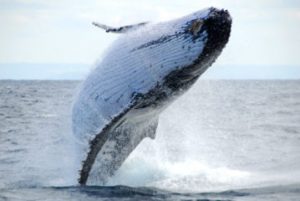Look out, there are whales about
 From now until early December, boaties need to keep a sharp eye out for humpback whales as these mammoth creatures move along the Queensland coast on their annual migration northwards from the Southern Ocean.
From now until early December, boaties need to keep a sharp eye out for humpback whales as these mammoth creatures move along the Queensland coast on their annual migration northwards from the Southern Ocean.
Minister for Environment and Heritage Protection and Minister for National Parks and the Great Barrier Reef Dr Steven Miles said the risks to boaties and others using the water became greater each year as whale numbers recovered from near-extinction following cessation of hunting in Antarctic and Australian waters.
“From a low of about 500 humpbacks travelling up our coast in the mid 1960s, we now have more than 20,000 making the journey from Antarctica each year to breed, calve, and enjoy the warmer waters,” Dr Miles said.
“The population’s recovery is one of the world’s great conservation success stories, and we reap the tourism benefits here in Queensland.
“The sight of these immense creatures and their calves parading past our coastline is a wonderful thing to behold. It’s a spectacle that draws people from interstate and overseas, to marvel at the humpbacks from whale-watching tour boats and headlands.
“People think of humpbacks as gentle giants, but they are known to nudge boats, and also to slap their tails or leap out of the water in explosive breaches close to watercraft.
“Remember that humpbacks are huge, unpredictable, 40-tonne mammals and you don’t want to get in their way. They travel at night as well as by day.
“Generally, a single boat cannot come closer than 100 metres from a whale, and a maximum of three boats are allowed within 300 metres of a whale at any one time.
“Within the 300 metre ‘caution zone’, boats cannot travel at more than six knots or create a wake.
“Personal watercraft such as jet skis must also keep 300 metres away.
“There is also a special interest declaration banning any boat or watercraft from approaching within 500 metres of white whales such as Migaloo.
“The approach limits are there for your safety and theirs. Details are at www.ehp.qld.gov.au. There are stiff fines for getting too close. The fines are higher for white whales such as Migaloo, giving them more protection against harassment.”
Dr Miles said it wasn’t possible to predict when or if Migaloo might arrive this year.
“There were unconfirmed sightings of Migaloo in Queensland waters in 2015. Researchers in New Zealand’s Cook Strait obtained a DNA sample from a white whale in July 2015 that was later confirmed as Migaloo.
“So we will just have to keep our fingers crossed that he’ll show up this year, and enjoy seeing all the other humpbacks in the meantime,” Dr Miles said.
He said that whale season also unfortunately meant the possibility of strandings.
Advice relating to whale strandings includes:
- If you see a stranded whale, report it as soon as you can to the RSPCA on 1300 264 625 (1300 ANIMAL).
- If you’re waiting for expert help to arrive, take care of your own health and safety first.
- Remember that whales can injure you with their head and tail and, like all animals, they can carry diseases than can be transferred from animals to humans.
- Do not attempt to push the whale back into the water, however tempted you are to do so, as this adds to the whale’s distress and potentially places you in danger.






